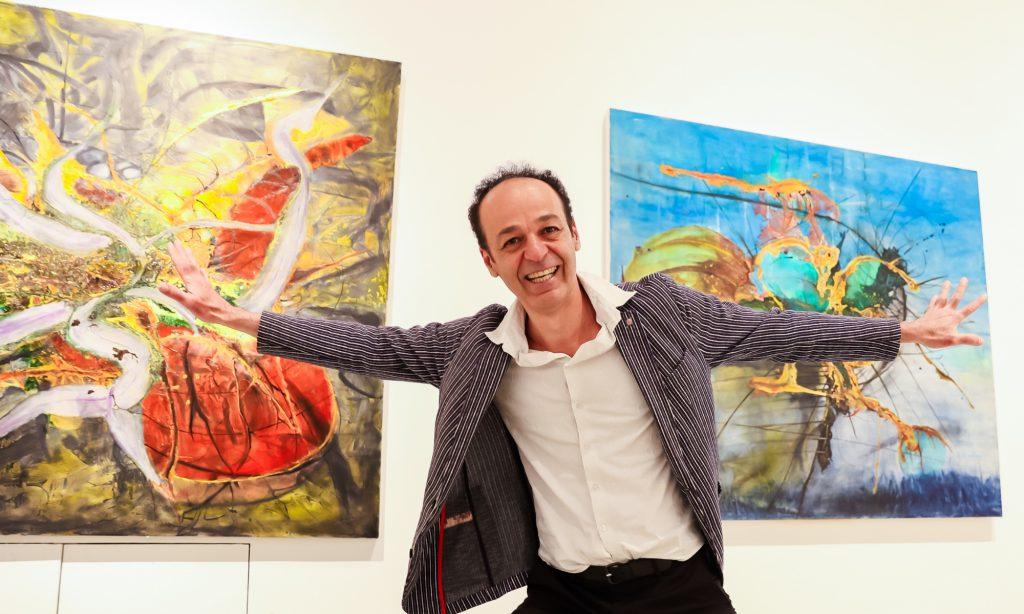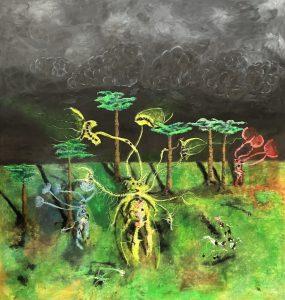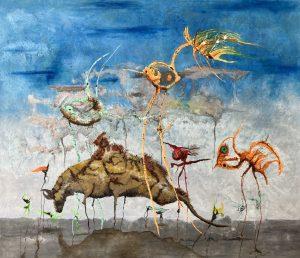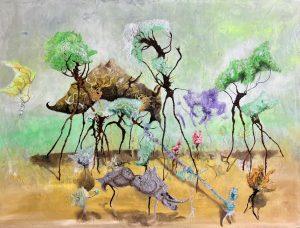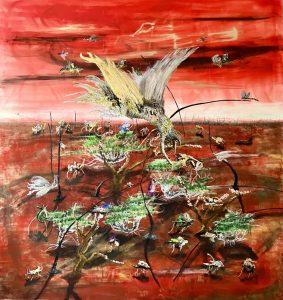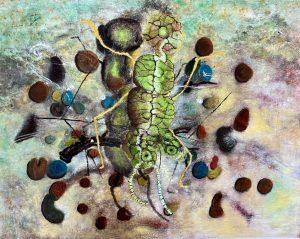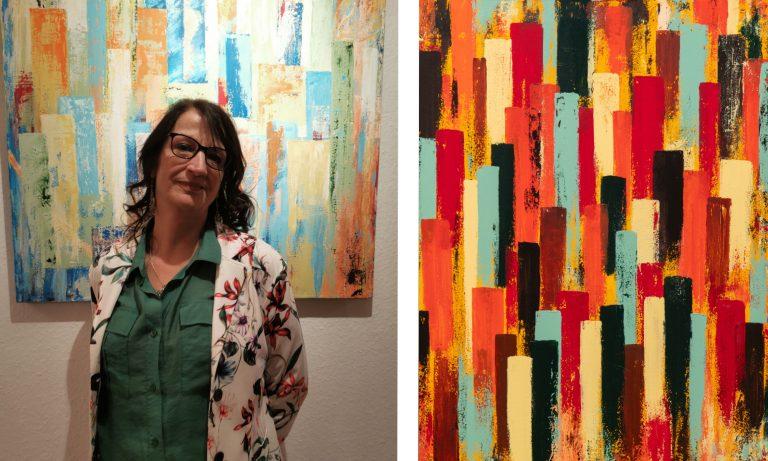Introduction
Hélios Boechat, a Brazilian-German artist, combines a unique academic background in economics, music, and visual arts to create a rich, multidimensional body of work. He studied economics at the Universidade Federal Rural do Rio de Janeiro (UFRRJ) and Universidade Federal Fluminense (UFF) and pursued music at the Conservatory Villa-Lobos in Rio de Janeiro and in Berlin. This diverse education, alongside his self-taught approach to visual arts, allows Boechat to merge different disciplines, producing works that challenge conventional boundaries and explore interconnectedness between life and energy.
Fluent in several languages, Boechat communicates his philosophical views on life and art to a global audience. His knowledge of music, particularly in piano and guitar, deeply influences his artistic practice, blending visual art with musical dynamics. Boechat’s work reflects his belief that all art forms—whether music, poetry, or visual art—share universal principles of harmony and dynamic expression, resonating with Horace’s Ut Pictura Poesis (“as is painting, so is poetry”).
At the heart of Boechat’s art is a philosophical inquiry into life, energy, and the forces shaping existence. He views life as a manifestation of energy that binds all living things, aligning with an evolutionary understanding of interconnected, evolving forms. Rejecting preliminary sketches, Boechat’s spontaneous approach to painting, particularly his “Natural Break” technique, captures the fluidity of life—its resilience, fragility, and continuous adaptation. His works, often featuring organic, abstract shapes, blur the line between natural and fantastical, inviting viewers to engage with the dynamic energy that defines both physical and metaphysical life. Boechat’s artworks embody his philosophical musings on life, energy, and evolution. Each painting is a dynamic expression of these themes, offering viewers a glimpse into a world where energy flows through all living things, constantly adapting and evolving in response to the universe’s shifting forces. Below are key examples of his recent works, each reflecting his ongoing exploration of life and energy through the lens of evolution.
Amrah, Slivly, and Quaran (2024) – Oil on Canvas, 150 x 160 cm
In Amrah, Slivly, and Quaran, Boechat creates a cosmic, energy-filled landscape populated by abstract, insect-like forms. The figures’ names suggest a connection to cosmic beings, transcending earthly life and representing a part of the universe’s energetic fabric. The glowing, pulsating energy of these figures symbolizes the constant transformation and diversification of life. The abstract nature of the painting invites the viewer to reflect on existential questions, exploring the origins of life and the forces shaping its continuous evolution. The painting serves as a visual meditation on the interconnectedness of all things and the universal flow of energy.
Planet Syncopia (2025) – Oil on Canvas, 160 x 150 cm
Planet Syncopia presents a vision of life that extends beyond Earth, where cosmic forces synchronize across vast distances. The title suggests a harmony or synchronization of energy across the universe, emphasizing the interconnectedness of all living things. This piece reflects Boechat’s belief in co-evolution—the idea that life forms evolve in response to one another. The creatures and plants depicted seem to emerge from a different dimension, embodying the concept that life’s energy is boundless and ever-changing, defying the limitations of time and space. Through this work, Boechat invites viewers to embrace the infinite potential of life’s evolutionary pathways.
Swimming Leaf (2024) – Oil on Canvas, 60 x 75 cm
In Swimming Leaf, Boechat transforms a simple leaf into an insect-like creature with six legs, two eyes, and an alien quality. The juxtaposition between the calm, natural image of a floating leaf and its transformation into a living, adaptive being reflects the concept of evolution and adaptation. This piece symbolizes the transformative power of life, illustrating how organisms can change their forms to survive and thrive in their environment—a visual representation of natural selection and evolutionary biology.
Balusians (2025) – Oil on Canvas, 95 x 110 cm
Balusians evokes both mystery and rootedness, featuring a large, earth-bound creature, like a prehistoric jackal, surrounded by smaller, insect-like entities. This surreal imagery is akin to Dalí’s The Elephants (1948), where elongated, fragile forms are distorted within an otherworldly landscape. The figures transcend their physical forms, symbolizing the constant flow of energy through the universe. The surreal name of the painting suggests the limitless potential of evolution, where life is not constrained by familiar forms but constantly evolving and adapting. This work challenges the viewer to consider life as an ongoing, interconnected process, shaped by cosmic forces that influence even the most grounded aspects of existence.
Garonias (2025) – Oil on Canvas, 90 x 120 cm
The name Garonias suggests an ancient, mythical quality, while the central creature—a hybrid of animal and plant—embodies Boechat’s fascination with the blending of different life forms. This piece represents the evolutionary tree, where different species converge, blur boundaries, and diversify. The creature’s form evokes both growth and transformation, reflecting the ongoing, adaptive processes of life. Through this dreamlike image, Boechat explores the potential for new forms of life to emerge and adapt, a central tenet of evolutionary theory.
Purilas (2025) – Oil on Canvas, 85 x 90 cm
Purilas depicts tall, slender beings reaching upward, symbolizing transcendence through energy. The figures’ movement toward a higher state of being echoes the evolutionary drive for greater complexity. The intense, fiery background contrasts with the luminous figures, suggesting a cosmic ascension beyond the physical realm. This work reinforces Boechat’s belief that life, at its highest form, is an energetic force capable of transcending earthly limitations—a visual metaphor for the continuous emergence of novel traits and evolutionary possibilities.
Conclusion
Hélios Boechat’s work combines innovative techniques with a philosophical exploration of life, energy, and evolution. His vibrant paintings, filled with dynamic textures and colors, capture the ever-changing nature of existence and the interconnectedness of all living things. Each piece embodies the principles of evolution, illustrating the constant flux of energy and life as they adapt to the forces of the universe. Through abstract, organic forms, Boechat reflects life’s resilience and fragility, pushing beyond traditional artistic boundaries. His art serves as a visual meditation on the energy that flows through all things, urging viewers to consider the broader philosophical implications of life’s continual transformation.
Boechat’s works have earned international acclaim with exhibitions in New York, Milan, and, in recent years, through Pashmin Art Consortia at the Beijing Archive Museum (2024) and Germany’s Greiz Castle Museum (2025). More projects are ahead in following years.
© Das Copyright of the Text belongs Dr. Davood Khazaie
LINKS:
